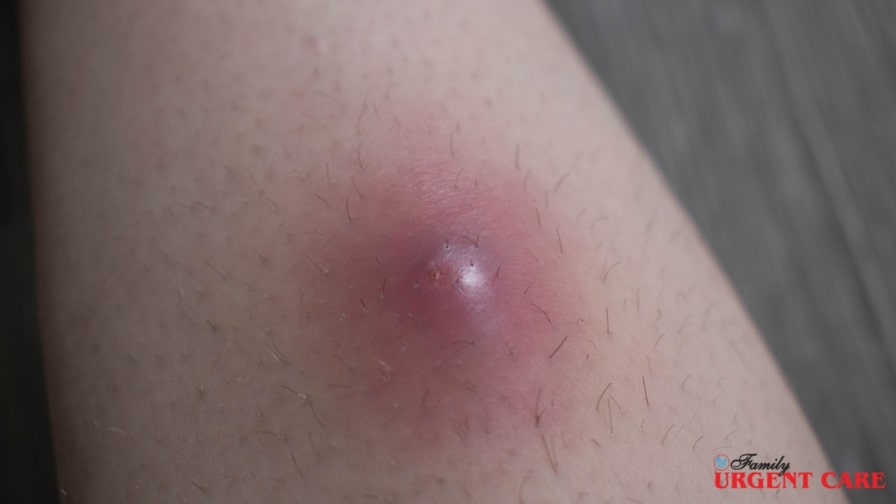You might have recently had a skin abscess drainage procedure and are wondering about the healing process and what to expect afterward.
Will it leave a scar? Can the abscess come back after drainage? We understand you might be confused with these mind-boggling questions.
Fret not! In this blog, you’re about to untie all the knots of doubt regarding the abscess drainage procedure, and the healing period. You’ll even find some handy tips below on speeding up your wound healing.
Without further ado, let’s get started!
What Are The Symptoms Of Skin Abscess?
Skin abscess often looks like a large pimple or a bump that is painful, swollen, red and tender when touched. A person may also notice a visible build-up of white or yellow pus under the skin.
An abscess can develop on any part of the body, such as the back, face, chest, buttocks, or lower abdomen. Many people also have abscesses in the underarms or groin area.
Some over-the-counter creams or oral drugs can heal small-sized abscesses. However, in most cases, a draining procedure is performed in addition to prescribing antibiotics.
What Is The Procedure For Draining The Abscess? Is It Painful?
Before a skin abscess drainage procedure, you might be concerned about the pain and discomfort. Don’t stress because the healthcare provider may use an anesthetic spray like lidocaine or bupivacaine to numb the area before the procedure starts, meaning that you won’t feel pain at all.
The procedure of abscess drainage is quite simple if you do not have any other complications. Here are the steps that the provider might take:
- The doctor numbs your skin using a local anesthetic
- A small incision will be made on the abscess
- Slight pressure is applied to drain the pus completely
- After complete drainage, the doctor cleans the area with normal saline
- The abscess is covered with a sterile gauze to prevent any germs from entering.
If you have a deep or larger abscess, the doctor may insert some sterile gauze after drainage to absorb the remaining exudate and prevent the immature closing of the wound.
What Can You Expect After Abscess Drainage?
After draining the abscess, you can expect your healthcare provider or doctor to follow these steps:
- Sample evaluation: The pus sample is sent to the lab for further analysis including culture and sensitivity.
- Prescribe medications: The doctor will prescribe antibiotics, antiinflammatory or other appropriate medicines that will help you recover from the infection.
- General instructions: After drainage, the healthcare provider may instruct you about wound care and changing the bandage once daily, as recommended.
- Watch out for infection: You’ll be asked to monitor the signs of infection at home and take care of the wound properly.
Precaution:
After drainage, the abscess may come back or become infected. Watch for symptoms like pus discharge, swelling, pain, or redness. Contact an urgent care provider immediately if you experience any of these symptoms.
How Long Does An Abscess Take to Heal After Drainage?
Generally, the drained abscess takes one to two weeks to heal, depending on several factors such as site of abscess, extent of infection and home care practices.
You migth notice a scanty discharge during the first 48 hours of the drainage procedure. And new skin will gradually form in about 2 to 8 weeks.
The complete recovery of the drained site depends on the following factors; age of the patient, their medical history and their medical condition. For instance, a diabetes patient or any similar chronic disease patient usually needs more attention and carefulness for a complete recovery.
Similarly, patients with drained sores should be very careful after the procedure since most elderly patients take time to fight bacterial infections.
Can The Abscess Come Back After Drainage?
With the proper management of the abscess and adherence to all home care measures, the abscess should not reoccur.
However, in some cases, such as an incomplete drainage procedure, bacterial resistance to the given antibiotics, or improper wound management, skin abscesses may return.
If the affected person has any other illness such as diabetes or chronic immunocompromised ailments, they may need extra care as abscesses can return.
If pus, inflammation, or hard nodules develop in the drained abscess, you should consult the doctor for further advice and manage the cause immediately.
How Can You Speed Up The Healing Process After Drainage?
If you’ve recently undergone an abscess draining procedure, you’d be eager to speed up the healing process. Here are some steps you can take to speed up the recovery:
- Change the gauze or bandage daily: If your doctor has packed the abscess pocket with gauze, replacing it with a newer one daily is paramount to prevent the spread of infection.
- Take medications timely: Antibiotics, pain relievers, or antiinflammatory medicines will ensure faster tissue repair and prevent abscess recurrence. Therefore, take the medicines as prescribed.
- Warm compresses: Apply a heating pad or warm compresses several times a day. Remember not to place the warm compress directly on the skin but first place a piece of cloth.
- Keep your bandage dry: Change your bandage as soon as it gets wet. This prevents bacterial growth and irritation, keeping the wound environment stable.
- Sitz bath or warm water soaks: Depending on the location of the abscess area, your provider may recommend sitz bath is recommended. For example: drainage of perianal abscesses.
FAQs
Can abscess heal naturally without drainage?
Some minor or small skin abscesses can heal on their own within a few days but if it doesn’t go away or there is persistent pain, swelling, or pus, then you need to see a healthcare provider right away. A large or internal abscess may need to be drained to prevent further complications.
Do abscesses leave permanent scars on the skin?
Yes, scarring is a sign that the drained abscess is healing properly. Initially, the scar may appear pink and raised. Over time, the colour becomes lighter or darker depending on the size of the abscess. There is a chance that abscess drainage might leave a permanent scar, but in most cases, proper wound care and treatments can minimize the appearance.
Which abscess size needs a draining procedure?
Medical experts say skin abscesses or boils more than 0.4 cm in depth require a drainage procedure. In most cases, antibiotics may not resolve pus formation, and the patient may have to undergo an incision and drainage procedure. It is essential to visit a healthcare provider for proper evaluation and assessment to decide whether drainage is a safer option.
Takeaway
In a nutshell, the recovery period after draining the abscess varies from person to person. The key is properly caring for the sore and following all the necessary steps to ensure faster healing.
If you have a painful, swollen, red lump or a visible pus or fluid buildup under the skin, you can contact our urgent care providers immediately.
The doctor will examine your skin, ask about your current medical condition and counsel you on the drainage procedure if needed. If you need a follow-up, you can contact our healthcare provider directly through video or phone consultations without leaving the comfort of your home.


























